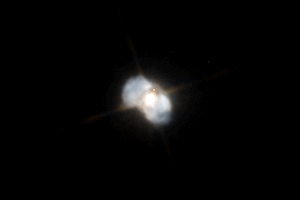Astronomy:IC 4997
| Emission nebula | |
|---|---|
| Planetary nebula | |
 | |
| Observation data: J2000 epoch | |
| Right ascension | 20h 20m 08.76s[1] |
| Declination | +16° 43′ 53.7″[1] |
| Distance | 14,090 (4,320 pc)[2] ly |
| Apparent magnitude (V) | 11.15[1] |
| Apparent dimensions (V) | 2.7″ x 1.4″ [3] |
| Constellation | Delphinus[4] |
| Physical characteristics | |
| Radius | 0.092 ly |
| Notable features | Bipolar outflow, Bipolar nebula |
| Designations | IC 4997 PNG 058.3-10.9 |
IC 4997 is a planetary nebula located in the constellation of Delphinus.[4] It was discovered in 1896 by Edward Charles Pickering and Williamina Fleming,[5] and independently by Gustav Gruss the same year.[6] This nebula is about 14,000 light-years from Earth.[2] It looks like an ordinary star in smaller telescopes, and only detailed study of its spectrum reveals its nebular characteristics.[7]
Physical characteristics
IC 4997 is very young and very dense with a very high nebular temperature of around 20,000 K,[8] which is twice those measured in most nebulae. The mean expansion velocity of the nebula seems to be slow at 20 km/s at the outer layer,[7] while it also reaches a maximum expansion velocity of 60 km/s relative to its central star.[8] Its central star has a magnitude of around 14m[7] and a temperature of around 47,000--59 000 K.[9]
The most characteristic feature of IC 4997 is its variability.[10] In the 1960s, there was a sudden change in its spectrum. Variability could be related to the nebula expansion[11] or an episodic smoothly changing stellar wind.[12]
See also
References
- ↑ 1.0 1.1 1.2 "IC 4997". SIMBAD. Centre de données astronomiques de Strasbourg. http://simbad.u-strasbg.fr/simbad/sim-basic?Ident=IC+4997.
- ↑ 2.0 2.1 Bailer-Jones, C. A. L.; Rybizki, J.; Fouesneau, M.; Mantelet, G.; Andrae, R. (2018). "Estimating Distance from Parallaxes. IV. Distances to 1.33 Billion Stars in Gaia Data Release 2". The Astronomical Journal 156 (2): 58. doi:10.3847/1538-3881/aacb21. Bibcode: 2018AJ....156...58B.
- ↑ Miranda, Luis F.; Torrelles, Jose M.; Eiroa, Carlos (1996). "The Double-Shell Structure of the Variable Young Planetary Nebula IC 4997". The Astrophysical Journal Letters 461 (2): L111. doi:10.1086/310017. Bibcode: 1996ApJ...461L.111M.
- ↑ 4.0 4.1 "The Sky Live". https://theskylive.com/sky/deepsky/ic4997-object.
- ↑ Pickering, E. C.; Fleming, W. P. (1896). "Harvard College Observatory, circular no. 9. Stars having peculiar spectra". The Astrophysical Journal 4: 142–143. doi:10.1086/140257. Bibcode: 1896ApJ.....4..142P.
- ↑ "IC 4997 in Celestial Atlas". http://cseligman.com/text/atlas/ic49a.htm#ic4997.
- ↑ 7.0 7.1 7.2 "IC 4997, Jim Kaler's STARS". http://stars.astro.illinois.edu/sow/ic4997.html.
- ↑ 8.0 8.1 Danehkar, A.; Parthasarathy, M. (2022). "Physical conditions and chemical abundances of the variable planetary nebula IC 4997". Monthly Notices of the Royal Astronomical Society 514 (1): 1217–1230. doi:10.1093/mnras/stac1364. Bibcode: 2022MNRAS.514.1217D.
- ↑ Feibelman, W. A.; Hobbs, R. W.; McCracken, C. W.; Brown, L. W. (1979). "Reversal of the [O III] lambda 4363/Hgamma lambda 4340 ratio in the planetary nebula IC 4997". The Astrophysical Journal 231: 111–114. doi:10.1086/157167. Bibcode: 1979ApJ...231..111F.
- ↑ Arkhipova, V. P.; Burlak, M. A.; Ikonnikova, N. P.; Komissarova, G. V.; Esipov, V. F.; Shenavrin, V. I. (2020). "Surprising Variability of the Planetary Nebula IC 4997 = QV Sge". Astronomy Letters 46 (2): 100–119. doi:10.1134/S1063773720020012. Bibcode: 2020AstL...46..100A.
- ↑ Kiser, J.; Daub, C. T. (1982). "Physical variations in the planetary nebula IC 4997". The Astrophysical Journal 253: 679–681. doi:10.1086/159668. Bibcode: 1982ApJ...253..679K.
- ↑ Miranda, Luis F.; Torrelles, José M.; Lillo-Box, Jorge (2022). "An episodically variable stellar wind in the planetary nebula IC 4997". Astronomy & Astrophysics 657: L9. doi:10.1051/0004-6361/202142730. Bibcode: 2022A&A...657L...9M.
Coordinates: ![]() 20h 20m 08.76s, +16° 43′ 53.7″
20h 20m 08.76s, +16° 43′ 53.7″
 |

